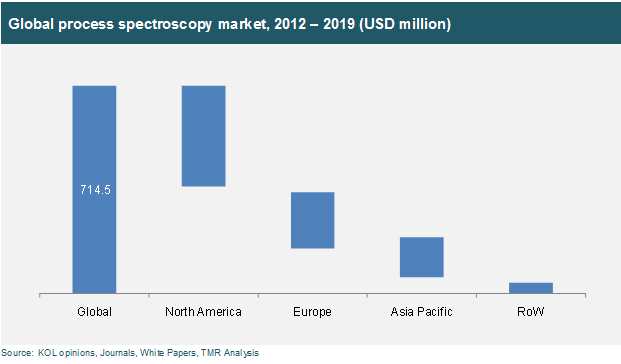The process spectroscopy market is expected to witness continuous growth due to rising popularity of spectroscopy technologies and growing consumer preference for high quality products. The innovative product development with technologically advanced features that are being incorporated in spectroscopy instruments is also driving the growth of process spectroscopy market.
View Full Report at http://www.marketresearchreports.biz/analysis/195874
Advance features in spectroscopy instruments include portability, handheld devices and integrated technologies.-. Other important factor supporting the growth of this market includes widening customer base in Middle East, Latin America, and Asia-Pacific.
Market was valued at USD 714.5 million in 2012 and is expected to grow at a CAGR of 7.4% from 2013 to 2019. North America was the largest contributor to global process spectroscopy market in 2012. Asia Pacific region is expected to be the fastest growing market for process spectroscopy during the forecast period with a CAGR of 8.7% from 2013 to 2019.
The global process spectroscopy market, with an impending demand for analytical solutions, is driven by intense focus of industries such as pharmaceutical, and food and agriculture, on matching international quality standards. As a result, there have been multi-pronged developments especially in spectroscopy technologies such as Raman and Fourier Transform Infrared (FT-IR). Several industries across the globe are demanding innovative solutions that could reduce the cost of analysis and scrap and rework. The table below highlights the current and forecast revenue of the market.
We can provide sample pages for the better understanding of this report. Request Sample of This Report, kindly Visit at http://www.marketresearchreports.biz/sample/sample/195874
 |
| MarketResearchReports.Biz |
Process spectroscopy is an application of spectroscopic techniques used to analyze a manufactured product in a cost effective and timely manner. A spectrometer generates signals that are used to perform an at-line or in-process measurement of the sample of the product. These signals are converted into graphical representations in order to obtain spectrum. This spectrum is then analyzed using software. There are several types of spectroscopy technologies such as near infrared (NIR) spectroscopy, Fourier Transform infrared (FT-IR) spectroscopy and Raman spectroscopy among others used for process spectroscopy. For instance, at-line measurement is done using near infrared (NIR) spectroscopy to measure the iodine value in a sample. Further, Raman spectroscopy is used to control the process for manufacturing titanium dioxides. This is an example of in-process spectroscopic analysis i.e. analyzing the samples during a manufacturing process. The signals generated are used for either controlling or monitoring the process of manufacturing the product.
The research study titled “Process Spectroscopy (Technology Types – Near infrared (NIR) spectroscopy, Raman spectroscopy and Fourier Transform Infrared (FT-IR) spectroscopy) Market - Global Industry Analysis, Size, Share, Growth, Trends and Forecast, 2013 - 2019” provides in-depth analysis of the market and related sub-segments.
The report strategically focuses on market segments such as process spectroscopy technologies and end-use industries and provides market insights and data about the size and growth of each segment.
The report includes detailed analysis of the prevalent market trends and company profiles. To provide better understanding of the competition in market, the report also includes Porter’s five force model analysis, value chain analysis, and market attractiveness analysis. The study on the global process spectroscopy market has been conducted with an objective of providing a thorough coverage of underlying technological and economic issues driving the process spectroscopy market. The report provides market data and forecast for the process spectroscopy technologies and end-use industry segments with an in-depth analysis of the global market, which has been further segmented on the basis of major geographical regions, from 2012 to 2019. The segmentation has been done to provide strategic insights for each category, enabling stakeholders across the value chain to gain considerable business intelligence.
The report aims to provide a comprehensive overview of market data and trends in North America, Europe, Asia-Pacific and Rest of the World (RoW) for emerging process spectroscopy instruments. The report identifies factors driving and restraining growth and future business opportunities in the process spectroscope manufacturing business. The competitive landscape section in the report provides market share analysis of major players in the global market in 2012.
Besides analyzing the global process spectroscopy market segment-wise, the report includes profiles of major players along with their market positions, business strategies and various recent developments. Companies profiled in the report include Thermo Fisher Scientific, Inc. Bruker Corporation, Buchi Labortechnik AG, Foss A/S, Danaher Corporation, Shimadzu Corporation, Yokogawa Electric Corporation, Sartorius Ag, Kett Electric Laboratory, HORIBA Limited and ABB Limited among others.
The global process spectroscopy market is segmented as follows:
Process Spectroscopy Market, by Technology
Near infrared (NIR) spectroscopy
Raman spectroscopy
Fourier Transforminfrared (FT-IR) spectroscopy
Process Spectroscopy Market, by End-use Industry
Polymer industry
Oil and gas industry
Pharmaceutical industry
Food and agriculture industry
Chemical industry
Other industries (medical diagnostic and environmental)
Process Spectroscopy Market, by Geography
North America
Europe
Asia Pacific
RoW
Process Spectroscopy Market (Technology Types - Near infrared (NIR) spectroscopy, Raman spectroscopy and Fourier Transform infrared (FT-IR) spectroscopy) - Global Industry Analysis, Size, Share, Growth, Trends and Forecast, 2013 - 2019
Source - MarketResearchReports.Biz
No comments:
Post a Comment